1. History of craft villages
The craft village in Son Dong is a traditional craft village of chiseling, carving statues and making worship objects, with a history of formation and existence for hundreds of years. The sophisticated gold-plated lacquer technique here is highly appreciated. During the French colonial period, many workers in Son Dong were protected by the State and awarded the title of artisan. From rough old jackfruit roots, through the talented hands of workers, many large and small statues have been formed, containing the thoughts, feelings, and respect of the people, conveying wishes for life. warm and happy.
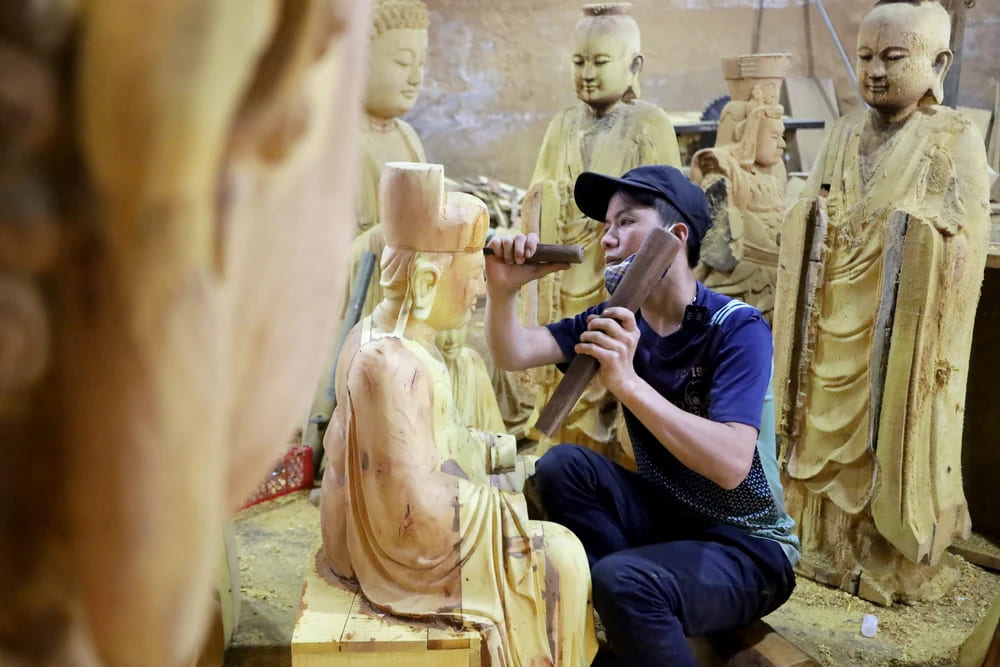
Legend has it that Son Dong craft village has been established and developed for thousands of years, since Buddhist culture was spread to Vietnam. During the feudal period, the craft village had hundreds of workers who were awarded the title of industrial protector (now called artisans). The physical imprints of 1,000 years of Thang Long - Hanoi all have the talented hands of Son Dong artisans participating such as Quoc Tu Giam Temple of Literature, Khue Van Cac, Ngoc Son Temple, The Huc Bridge, One Pillar Pagoda. ..
Son Dong handicraft village was lost during the years of resistance against the US and the subsidy period, but was later restored by artisans Nguyen Chi Dau and Nguyen Duc Cuong in 1983. Mr. Nguyen Chi Dau, artist During the French colonial period, people decided to restore the traditional craft by organizing classes to learn wood carving and lacquer, mainly to pass on the craft to their children and grandchildren. More than 30 students that day have now become good workers, owners of large production facilities in the village and are continuing to pass on the profession to the younger generation. Up to now, the village's profession transmission is mainly passed down through family, directly, from father to son, son to grandchild, continuing from previous generation to next generation without any recorded documents. Having gone through ups and downs to survive a thousand-year-old craft village, today, Son Dong people have taken the 6th day of the second lunar month every year as the village festival, where children and grandchildren from everywhere come together to worship the tutelary god. village.
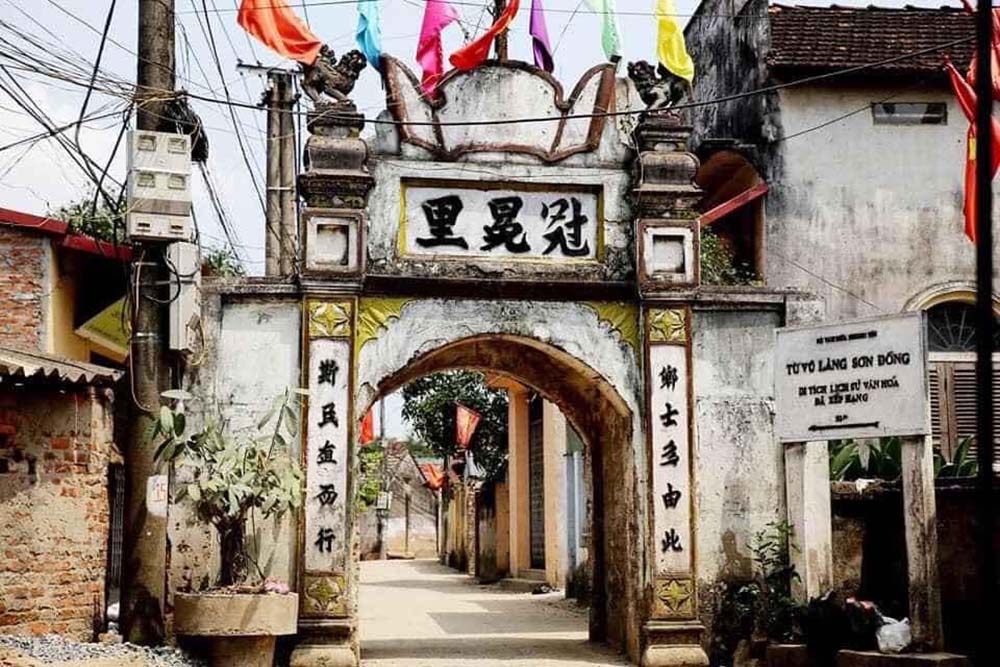
Currently, the whole commune has more than 4,000 workers regularly working in handicrafts, of which more than half are good workers and many good workers are honored and awarded the title of artisan. Products of Son Dong Handicraft Village account for over 50% of the national market share of statues and altar objects painted in red and gold, silver-plated and covered in golden colors, serving the cultural, spiritual and religious life of the people. . What is worth mentioning is that if customers need to order any worship statue, the workers here can do it right away without the need for a birth model (existing model). The statues become soulful through the skillful hands of the craftsman. To do that, the craftsman is required to have experience, understand the history, personality, position, and position of each statue in the mind to then breathe life into the works.

2. Manufacturing process and products
Regarding the manufacturing process, in addition to the general formula inherited from their ancestors, each artisan in Son Dong also has his own techniques and esoteric techniques with not entirely the same way of division and proportion. For example, when an artist carves a sitting Buddha statue, he often carves four faces (the face from the hairline to the chin is called "face". In modern plastic surgery, it is called "one head"). But sometimes Buddha only has three and a half faces, or four and a half faces. Sometimes, to make a standing statue, you have to "erect" up to seven sides. The common point among artisans when making statues is that they all take the face (equal to one head) as the standard to calculate the proportions. The proportions of the sitting statue are four faces and the standing statue is seven faces. In addition, regarding the height of the statue's body, the following formulas must be followed: statue's shoulder width: from 2 to 4 faces; long sleeve: 3 sides; The body thickness is from 1.5 to 2 faces. That formula can change depending on whether the statue is fat or thin, male or female (fat statues have high body thickness, male statues have wider shoulders than female statues...).
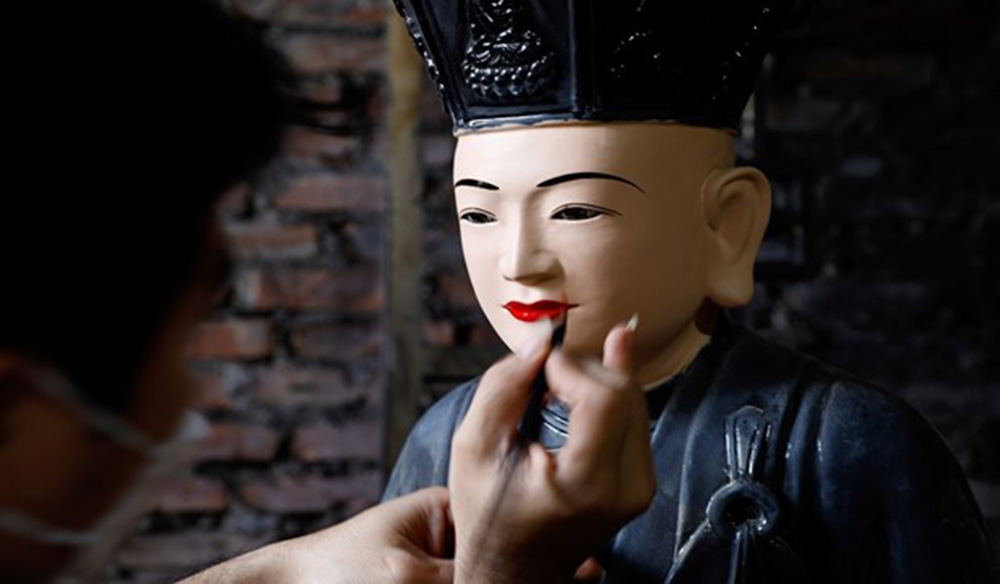
Carving a statue always starts with choosing wood. The common raw material for making Buddha statues is jackfruit wood, while making altarpieces there are also doi wood and yellow heart wood. Jackfruit wood has the characteristics of flexibility, softness, and fine grain, thereby avoiding mistakes while chiseling. Jackfruit wood is also highly durable, rarely cracks, and easy to peel. Son Dong people have to buy jackfruit wood from provinces such as Phu Tho, Thai Nguyen, Thanh Hoa, Nghe An... The wood transported has all the senses removed, only the core is used to chisel. Then, the craftsman uses a volume measuring tape to cut the wood: height, width and thickness (the size of a block), then cuts the "template" - the pattern cut in a two-dimensional "curve": inclined direction (side view of the statue) and vertical direction (front view). The first processing part is the statue's head and face. Chisel outline the hat blocks (if any) then the forehead, nose, lips, ears... On the statue's face, the craftsman also divides each segment, representing the distance between the two eyes, from the hairline to the eyebrows, length of nose bridge, width of nose wing, distance between upper and lower lip, from lower lip to chin, lip thickness...The markings are the most difficult and important part of the statue's face. For Buddha statues, especially Buddha ears, the distance from the hairline (on both sides of the head) to the chin must be calculated to be properly balanced. After chiseling and drawing the general shape all the way from the surface to the base, to the detailed chiseling, the craftsman also gradually shows each part. This step is considered the most important in the entire process of completing the statue. Finally, the step is peeling, scraping, and then sanding until smooth. While sharpening, the craftsman uses a thin, flat chisel to separate the details, so that the blocks (limbs and fingers) do not "stick" to each other, especially the curves and pieces must be carefully shown. . Peeling is the process of completing the wood part before moving on to painting.

The technique of painting vermilion and gilding statues is as elaborate as the art of making lacquer. First, "cut" the statue with paint mixed with alluvial soil (the ratio is such that it is not too young, nor too old), then "bundle" it with live paint and then "thi" paint. After each step, the statue must be ground with stone and water. Paint it, then grind it again, then paint it again..., and so on, when you see that the statue's surface is smooth and plump, use a layer of paint (called Cam Thup paint) to cover it. To make the paint sticky (still a little sticky when touched), paste silver or gold (silver, gold) depending on the customer's request. Litmus is a powder made from gold and silver rubbed on a thin sheet of paper (litmus paper). People take thinly laminated gold and silver leaves (the old kind), cut them into square pieces, put them between sheets of paper, and then use a hammer to beat them evenly until the gold dissolves into powder. Gold, silver, and anemone are bought by Son Dong artisans from Kieu Ky gold and silver plating village, Gia Lam district - Hanoi, the only place in the country still doing this profession.
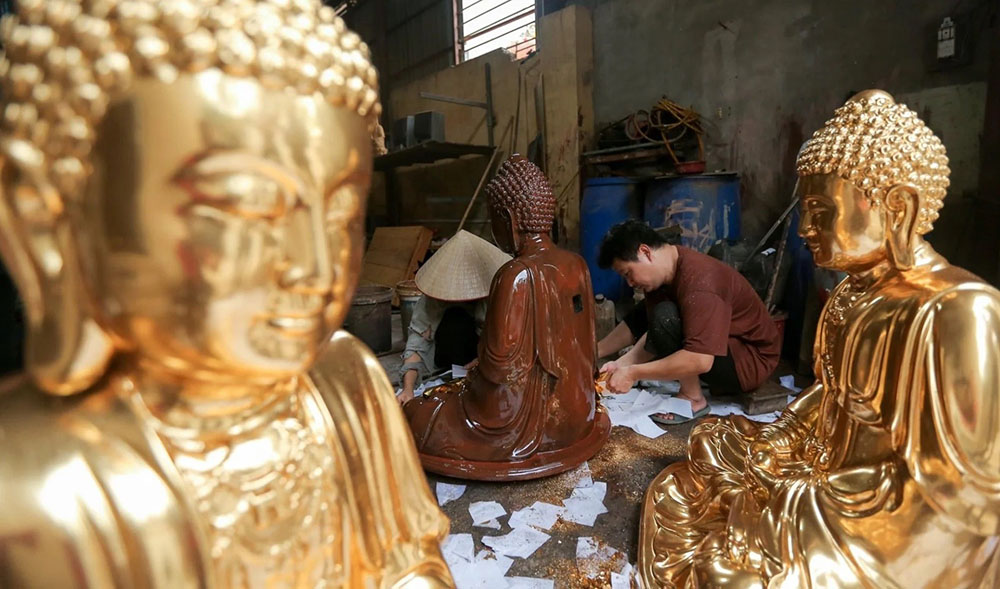
Gold and silver plating in Kieu Ky has a history of several hundred years, thanks to the village's founder, the famous man Nguyen Quy Tri (mandarin of the Canh Hung Dynasty), who learned the craft when he was a Chinese envoy and came back to teach it. Gold-plated wooden products are created through 14 stages such as: peeling paper, scraping new paper, breaking paper, cutting nong... Each stage has many smaller stages, totaling up to more than 40 stages. of different sizes to produce finished products, thus requiring workers to be persistent and meticulous with highly technical operations. Making a statue is the most difficult, the craftsman must be able to breathe life into the statue, look at it with a shape, and customers will immediately recognize which statue it is... Son Dong people from young to old have great respect for Buddha statues , all call the statue Mr. or Him.
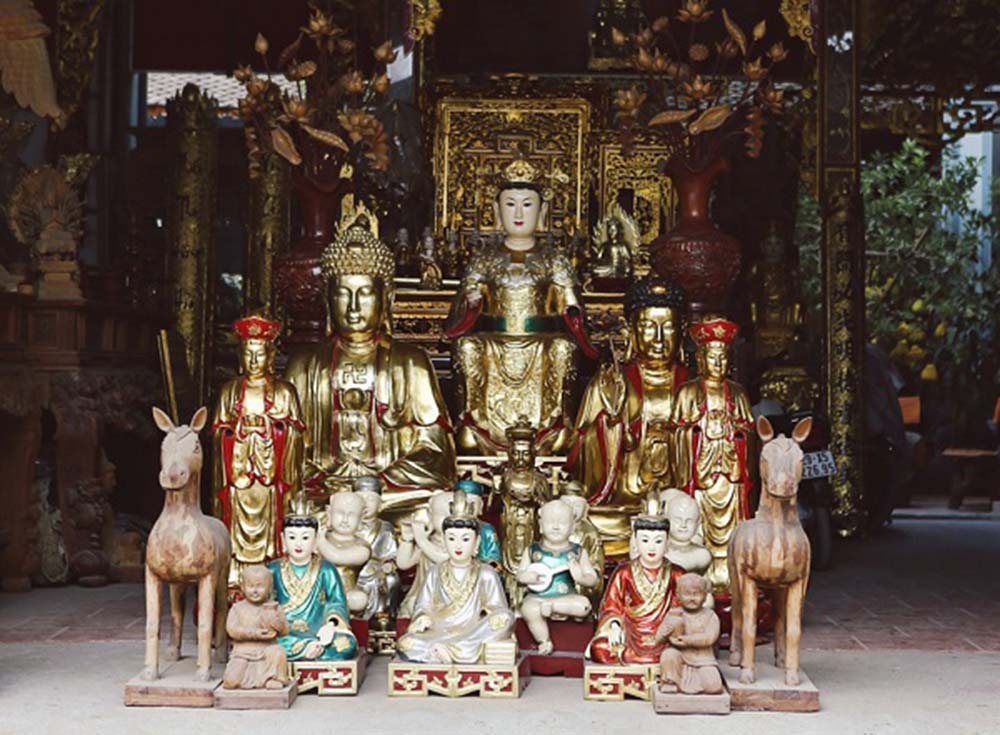
The fruits that the Son Dong workers obtained after many days and nights of hard work in the wood workshop are not only famous throughout all parts of the country, but also far away to many countries around the world. When mentioning Buddha statues, people immediately think of Son Dong. With talented hands, Son Dong village's craftsmen have created many works of art that require high sophistication such as the thousand-armed, thousand-eyed Buddha statue, the statue of Mr. Thien, Mr. Evil, the statue of Arhat, bowl and tribute palanquin... Wherever you go in the country, visitors can encounter worship statues crafted by Son Dong craftsmen.
3. Artisans and production facilities
Coming to Son Dong today, visitors will be able to witness firsthand the process of making statues and be immersed in the "music" of the craft village with the clicking sounds of the statue carvers and the sound of saws echoing throughout the alley. neighborhood. Indeed, when witnessed, one can see all the hardships and hardships of the workers, when each completed work of art contains within it the sweat and wisdom of the barefoot workers. Many people in Son Dong today have to exclaim that it is the hundreds of years old profession of their ancestors that has helped them get rich and create jobs for thousands of workers, while the land is shrinking due to the pace of urbanization. highly urbanized. People still silently thank the artisans who have contributed to restoring the craft village. There are households who have been working in the craft for many generations and have continued to write the history of Son Dong craft village that people cannot help but mention such as artisan Nguyen Viet Thac, Nguyen Ba Khan, Tran Quang Khang…
There are workers from the past who have now become big factory owners in the village, with 3 factories, operating year-round, always with 40 - 50 hired workers, notably Mr. Nguyen Chi Quang, Mr. Chi Dung, Tran Dinh Cuong, Nguyen Viet Hong,... Up to now, the whole commune has more than 5 households establishing companies to promote trade and sign contracts with domestic and foreign customers. During the period of international economic integration, many Son Dong workers also made portrait statues and fine art statues for export, meeting the needs of foreign partners. Many overseas Vietnamese, after visiting Son Dong craft village, placed orders and even invited workers abroad to make statues in communal houses and pagodas to serve the Vietnamese community there. Now, the value of statues is much higher than before, with some statues ordered by customers for hundreds of millions of dong.
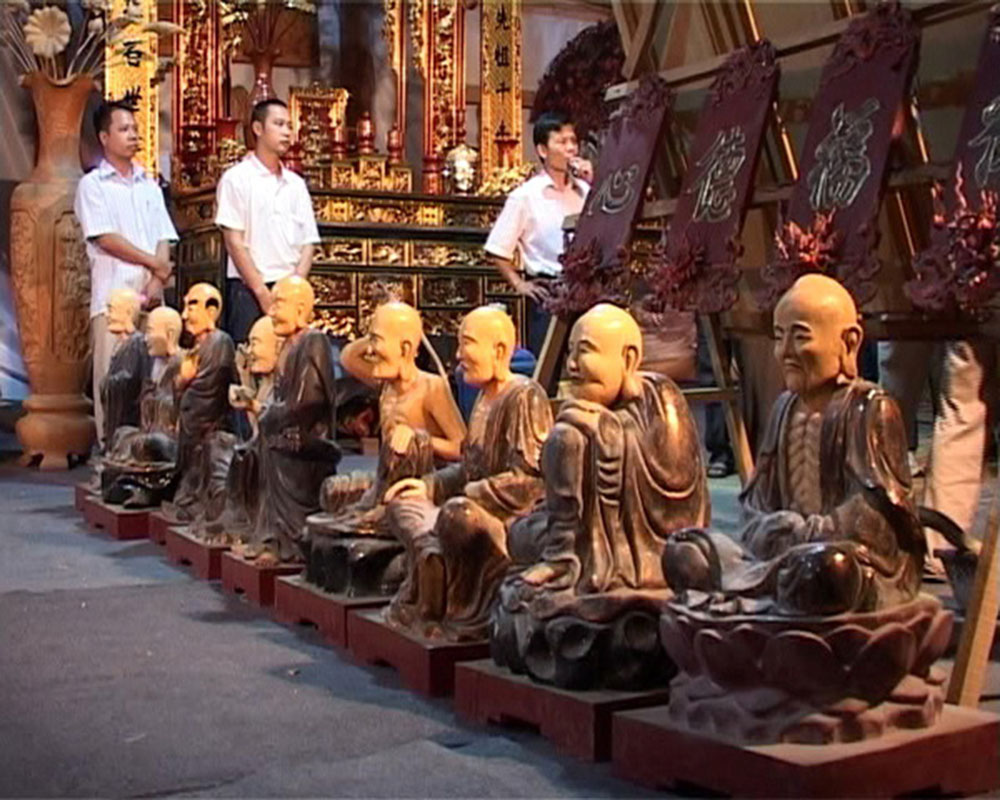
Mr. Nguyen Duc Dau (1896-1988) was instrumental in restoring the profession of Son Dong statue carving after many years of ups and downs. With his excellent skills, Mr. Dau was honored by the French and given a "golden coin" at the Trick Fighting Festival. In 1986, Mr. Dau opened a vocational training class for more than 30 young workers in the village. Since then, more than 30 craftsmen have gradually grown up and continue to teach their skills to the current generation of young workers...
